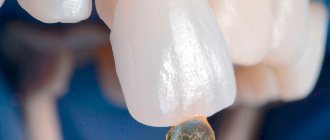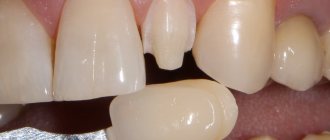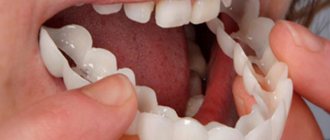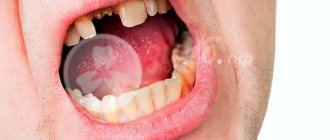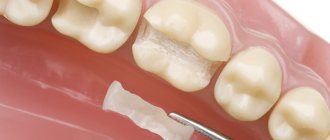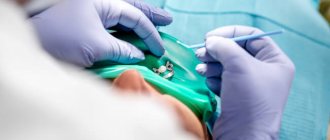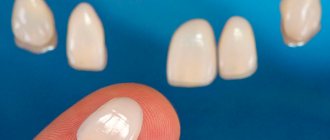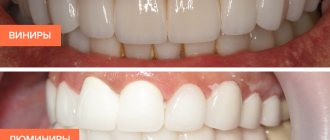What is the procedure for dental restoration? What is direct and indirect restoration method, the pros and cons of these dental procedures (advantages and disadvantages).
If you cannot boast of a beautiful smile due to the less-than-ideal condition of your teeth, or if you have suffered an injury as a result of which a piece of your teeth broke off and a crack appeared on it, then you should not despair at all! The beauty and charm of your smile will be restored to you by such a modern dental procedure as dental restoration .
Dental restoration
Dental restoration is designed to perform the following tasks:
- Restore the shape, color and normal size of teeth;
- Restore their previous functionality;
- Cure carious manifestations;
- Remove gaps between teeth and align their position in the jaw row;
- To give the teeth the most aesthetic, attractive appearance possible, and the augmented tooth must be absolutely identical to the natural one.
Dental restoration – what is it anyway?
Artistic dental restoration allows you to restore the shape and basic functions of damaged teeth using filling materials. With the help of the dentist’s skill, it is possible to restore the natural whiteness of the smile, eliminate existing defects in the dentition and achieve high aesthetics of the teeth.
Artistic dental restoration is a unique technique for restoring minor defects in the crown of teeth, making them more aesthetically pleasing and making your smile as attractive as possible. For this purpose, modern dental materials are used that imitate dental tissues and give the teeth the desired external characteristics.
Stages of implementation
- Selecting the color of the material from which the veneer will be made;
- Tooth preparation: depending on obtaining the required thickness, its surface is ground down from 0.5 to 1.5 mm;
- Taking an impression;
- Fixing temporary veneers on the tooth surface to protect the tooth surface while permanent veneers are being made;
- Making a plaster model of teeth in the laboratory. Then, according to this model, veneers are made in various ways and methods.
- Fixation of permanent veneers by gluing them to the tooth surface using composite glue;
| Advantages of indirect restoration |
| Ceramics as a material for restoration prevents the formation of dental plaque. |
| Ceramics do not change color and shine over time and do not wear off. |
| The walls of the tooth are strengthened by bonding with ceramics. |
| With the help of veneers or inlays, you can avoid further grinding down of the tooth to cover it with a crown. |
| By making veneers or inlays on a model, it becomes possible to view the work from any angle and, accordingly, achieve a more precise fit of the material to the tooth surface. |
| The chewing surface is restored in the laboratory taking into account chewing movements, so when an inlay or veneer is installed, the original functionality of the tooth is completely restored. |
| It is possible to restore several teeth at the same time. |
| The number of visits to the dentist is reduced from 4-5 to two. |
Prices for dental restoration in Moscow
Artistic restoration of teeth in Moscow is carried out in Vimontale. The method of tooth restoration is selected individually. When choosing the most suitable method, several factors are taken into account: the patient’s age, the nature of the enamel damage, general health, and the condition of the pulp. We offer the most affordable prices for dental restoration.
Service Price
Consultation with an orthopedic dentist, drawing up an orthopedic treatment plan 0 rub.
Anesthesia - application 100 rub.
Anesthesia - infiltration 400 rub.
Ceramic veneer E-MAX Up to 5 teeth 20,000 Promotion
Ceramic veneer E-MAX Over 8 teeth - 25% discount 15,000 20,000 rubles
Ceramic veneer E-MAX From 6 to 8 teeth - 15% discount 17,000 20,000 rubles
Aesthetic restoration 3,000 rub.
Production of a diagnostic model RUB 1,000.
Diagnostic model made of plaster 490 rub.
Diagnostic model made of class III-IV supergypsum 690 rub.
Polishing 1 tooth 90 rub.
In what cases is the dental restoration procedure used?
The procedure allows you to solve the following problems:
- carious damage to most of the frontal tooth surface;
- gaps between teeth;
- chips and damage to enamel;
- more than 50% destroyed crown;
- changes in enamel shade.
Aesthetic restoration provides an opportunity to correct the shape and color of teeth. After the procedure, they look natural and match the appearance and function of healthy teeth.
The cost of such a procedure depends on the nature of the defect and the methods used to eliminate it. This issue can be discussed at a clinic appointment.
Features of the procedure
Artistic restoration is the general name for various methods and technologies of aesthetic dentistry aimed at restoring the appearance and functionality of the front and chewing teeth.
The advantages of modern treatment methods are their minimal invasiveness and safety. Our doctors use hypoallergenic drugs and consumables, resort to the minimum possible tooth preparation, and use professional dental binoculars and a microscope.
Restorative methods are more accessible compared to prosthetics, and they can be used in cases of significant destruction of enamel and dentin (but not more than 50%). In most cases, the doctor resorts to aesthetic imitation of dental tissue using composite materials. As a result, you will be able to solve your problems in an average of 1–3 visits to the clinic, depending on the scale of the problems.
Methods of aesthetic dental restoration
Methods for correcting imperfections in the shape, color and arrangement of elements of the dentition are usually divided into direct and indirect. In the first case, we are talking about a one-time visit to the dentist to restore aesthetics through the use of filling materials. Using photopolymers and composites, you can correct chips, cracks, scratches in enamel, discoloration, and also restore damaged crowns.
Indirect dental restoration involves correction using structures individually manufactured in the laboratory - crowns, veneers, inlays. This will require several visits to the dentist for preparation, taking an impression and fixing the finished structure.
Crowns are used if the tooth is destroyed by more than 50%. They use structures made of metal-ceramics and ceramics. They look natural, are durable and last 10–20 years.
Veneers are thin plates (0.5–0.7 mm) that make it possible to hide such defects: small gaps between the teeth of the frontal group, chips of the cutting part, discoloration of the enamel, unsightly shape of the dental unit. The designs are resistant to food coloring and retain their shine.
Dental restoration with inlays is applicable for significantly damaged teeth in the lateral chewing group. Microprostheses are made according to the shape of the defect and ideally restore the coronal part. The material is ceramics, whose properties and appearance are similar to natural dental tissues.
In Moscow, you can take advantage of direct and indirect dental restoration at the Vimontale clinic. We use advanced technologies and materials to restore the beauty and natural appearance of teeth. Sign up for a free consultation to find out which method of front teeth restoration is right for you and what the cost of the entire range of work is.
Our patients save money through promotions and discounts (check the website). We also cooperate with insurance companies.
The clinic's specialists make sure that your smile is beautiful and healthy!
Restoration of anterior teeth
We need the front teeth for normal chewing no less than the side teeth. If you have one or more of your front teeth destroyed, it will be difficult for you to bite off a piece of a green apple or crack a cracker.
However, the restoration of front teeth is of particular importance for a person’s social comfort. Therefore, in good clinics, aesthetic restoration of anterior teeth and their treatment are inseparable processes.
There are two restoration methods:
- Direct – involves modeling and restoring teeth directly in the patient’s mouth. In this case, composite materials are used - photopolymers and glass ionomers.
- Indirect (orthopedic) – an impression of the patient’s jaw is made. Then, structures from ceramic, zirconium or other materials are modeled and manufactured in the laboratory. In this way, it is possible to restore an almost completely lost tooth, but this already relates to the field of prosthetics.
Restoration of anterior teeth is performed using both methods. Each of them has its own advantages, disadvantages and areas of application.
The doctor decides which method will be used for you personally, based on the individual situation and the problems that the procedure should solve.
Dental restoration methods: direct and indirect
Artistic restoration can be direct, in which the main manipulations are performed in the oral cavity, and indirect, when replacing structural defects are made in a dental laboratory and taking into account individual measurements and parameters. The specific option is selected by the patient with the help of the dentist. Indirect restoration is more aesthetically pleasing and durable, but is more expensive.
Direct restoration of teeth with composite material (filling)
The direct method of artistic restoration is carried out using high-quality composites that are resistant to stress, adverse thermal and chemical influences, and pathogenic microorganisms. The procedure is carried out in several stages.
Artistic restoration can restore the aesthetics of teeth that were previously depulped. To increase the reliability of restoration materials, a pin is installed in the root canal. This makes it possible to strengthen the composite material used and increase the service life of the restoration.
During dental restoration using composites, teeth are reliably isolated from high humidity and contact with the patient’s saliva using latex materials that have appropriate holes for the teeth. If the doctor does not pay due attention to this issue, then the service life of the filling material is sharply reduced and due to the loose fit of the filling to the tooth, caries may occur.
The dentist applies filling materials in layers that match the tone of the patient’s teeth. During this, a composite of different shades and degrees of transparency is used, thanks to which it is possible to obtain the most natural shade of tooth enamel. The final stage is the final correction of the shape of the teeth, grinding of excess areas and visible irregularities. The restoration becomes indistinguishable from natural tooth enamel.
Direct aesthetic restoration of teeth - advantages and disadvantages
The main advantage of direct restoration is the speed of correction of existing enamel defects. The procedure takes no more than 30-60 minutes and is completed in one visit to the dentist. The disadvantages include the relatively short period of time for preserving the aesthetics of the restoration: after 1.5-2 years, composite materials begin to turn yellow, as they absorb dyes coming from food and drinks.
Indirect restoration
Indirect artistic restoration involves the use of dental inlays and ceramic veneers. Modern ceramics can withstand intense chewing loads and at the same time look as natural as possible. With the help of such restorations, you can easily recreate the volume of damaged enamel and make unevenness and chips on the crown of your teeth invisible.
Artistic restoration is always recommended to be carried out after professional teeth cleaning, whitening and plaque removal. These preparatory measures help to slightly whiten the enamel and eliminate colonies of microbes that can provoke the development of infectious complications after restoration. Using a special scale, the dentist selects the most suitable color of materials that will be used to correct enamel defects.
Subsequently, the carious cavities are excised. If necessary, local anesthesia can be used. Old fillings that have lost their aesthetic appearance must be replaced. Restorative structures are made from individual impressions in a dental laboratory.
Veneers
Veneers are thin microprostheses. They are used in dental restoration to create an ideal smile. The plates are most often made from ceramics. Before installing them, it is necessary to grind down the tooth enamel a little. But composite veneers made from high-quality light-polymer materials are also in demand.
Aesthetic dental restoration with veneers - advantages and disadvantages
Properly carried out artistic restoration of teeth can eliminate all existing dental defects:
- change the tone of tooth enamel;
- correct the shape of the teeth and their position in the dentition;
- eliminate excessive gaps between teeth;
- restore the aesthetics of your smile.
Artistic restoration with veneers does not require pulp removal or significant grinding of enamel and is considered a fairly comfortable procedure. With its help, it is possible to keep teeth alive, as close to natural as possible.
The disadvantages include the relatively high cost of ceramic veneers. But the price corresponds to the materials used, technologies and the final result.
Indirect restoration
Indirect restoration – tooth reconstruction with microprostheses: veneers, dental inlays. The latter are used if the installation of a filling is ineffective (the coronal part is destroyed by 20-25%), and the tooth needs to be saved. Dental inlays are made in the laboratory using the patient’s impressions and accurately replicate the shape of the tooth and its natural shade.
In case of significant problems with shape and color, veneers are used - thin plates made of ceramic, porcelain, zirconium, photopolymer composites, which are fixed to the outside of the dentition with a special adhesive. The thickness of the veneer is 0.1-0.3 mm. Veneering is indicated for the restoration of teeth along the smile line (up to the 5th premolar). Typically, such microprostheses are fixed on 6-8 upper front teeth and 4-6 lower ones. Veneers are not placed on chewing units due to the high chewing load to which they are regularly exposed.
If it is necessary to eliminate a visual defect of one incisor/canine, we recommend restoration with nanocomposites. When restoring the aesthetics of several front teeth, the optimal solution is the installation of ceramic veneers.
Restoration of chewing teeth
To restore chewing teeth, recreate their shape and the strength of hard tissues, composite materials and special inlays are used that replace the missing parts of the enamel.
Expert of the article you are reading:
Bystrov Alexey Albertovich
Dentist orthodontist, general dentist
You may also be interested in:
Ceramic veneers Lumineers price for 1 tooth in Moscow Ceramic veneers E-max
Show more
Contraindications
Unlike the direct method of restoration, the indirect method has a number of contraindications:
- The patient has an incorrect bite;
- Pathological abrasion of teeth;
- In the absence of one or more chewing teeth;
- Bruxism is the habit of biting nails, threads, and other objects with teeth.
- Passion for extreme sports or unusual lifestyle that involves injury
- The presence of extensive destruction of the internal tooth surface
- Large filling on a tooth requiring the installation of a veneer
Our patients
Patient recommendations
Akhmedkhanov Said Rashidovich
Dental surgeon, general dentist, implantologist, orthopedic dentist, dental therapist.
Make an appointment 8 (499) 520-98-70
Make an appointment
Recommendations from patient Alekseeva O.V.
Akhmedkhanov Said Rashidovich
Dental surgeon, general dentist, implantologist, orthopedic dentist, dental therapist.
Make an appointment 8 (499) 520-98-70
Make an appointment
Recommendations from patient Zolotareva S.V.
Akhmedkhanov Said Rashidovich
Dental surgeon, general dentist, implantologist, orthopedic dentist, dental therapist.
Make an appointment 8 (499) 520-98-70
Make an appointment
Recommendations from patient Vera
Akhmedkhanov Said Rashidovich
Dental surgeon, general dentist, implantologist, orthopedic dentist, dental therapist.
Make an appointment 8 (499) 520-98-70
Make an appointment
Recommendations from patient Mikhail Ivanovich
Akhmedkhanov Said Rashidovich
Dental surgeon, general dentist, implantologist, orthopedic dentist, dental therapist.
Make an appointment 8 (499) 520-98-70
Make an appointment
Collapse

